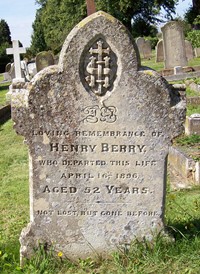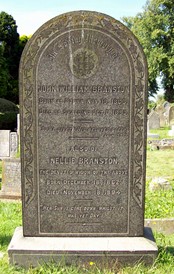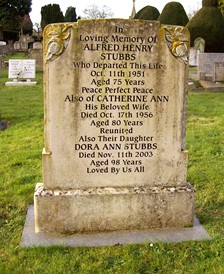|
Epitaphs
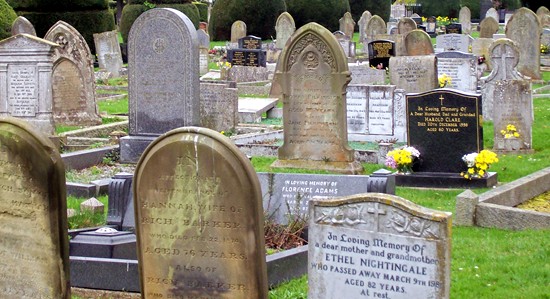
Inscriptions from the past provide a
rich source of information about those who went before, often as a brief
characterisation of their personality or perhaps a favourite thought
beloved during their lifetime. These short and pithy sayings, often in
verse, can be found on memorials in many public places, on statues,
monuments and plaques, but by far the best place to see them in all of
their fascinating detail is on the tombstones in our churchyards and
cemeteries.
Burials in our graveyard adjoining the Abbey Church at Bourne date from
the earliest times until 1855 when they were switched to the town
cemetery. There was no more space and some plots had been used two and
three times for interments with bodies stacked one upon the other, making
the erection of tombstones for each one a difficult task. Those memorials
that have survived have been the victims of the weather and much of the
lettering has been rendered undecipherable through erosion by wind and
rain but those which can be read will give delight.
Religious texts were the most popular and there is one corner of the
churchyard with a particular poignancy below the east window, an area that
was much sought after because it catches the early morning sun and
therefore contains some of the grandest memorials in the churchyard, large
sarcophagi with elaborate inscriptions intended to remember the great and
the good of this town. They departed this life with grand funerals and
perhaps a horse-drawn hearse with black frock-coated mourners following on
but here they lie in one of the most neglected sections, and few who visit
have even heard of their names, Dyer and Layton, Mawby and Munton, Osborn,
Harbut, Phillips and Dove, all once leading citizens of this town but now
totally forgotten. One of the biblical quotations from Ecclesiastes 1
provides an appropriate epitaph: "Vanity of vanities; all is vanity."
Another of the ancient tombstones in the churchyard contains a curious
verse, slowly eroding, dedicated to Thomas Tye, a blacksmith, of Star Lane
[now Abbey Road], Bourne, who died in the early years of the 19th century:
My sledge and hammer lie
reclined,
My bellows too have lost their wind,
My fire's extinct, my forge decayed,
And in the dust my vice is laid,
My coal is spent, my iron's gone,
My nails are drawn, my work is done,
My fire-dryed corpse lies here at rest,
My soul like smoke is soaring to the bles't.
The memorial stone for Thomas Knott, who
died on 7th July 1832, aged 48 years, also has a philosophical
inscription:
Afflictions some long time he
bore
Physicians were in vain
Till God did please to give me ease
And free me from my pain.
|
WISE WORDS FROM THE
PAST
This slate memorial
which can be found in a corner of the churchyard was erected to
the memory of Benjamin Ferraby, a Bourne veterinary surgeon, who died on 30th October 1838 at
the age of 50, and his wife Mary who died on 17th November 1834,
aged 53. It also contains an inscription that is still relevant
today:
Praise
wrote on tombs is often vainly spent
The
honest man is his own monument. |
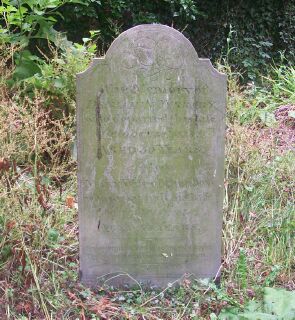 |
Slate memorials which were once popular
fare better because they can withstand the elements and many of those that
have survived are still readable. There is also one over a
servant's grave in the churchyard at Bourne, erected in memory of a
long-serving family butler who must have been highly valued to have been
so remembered. The inscription states: "In memory of James Drew who
departed this life June 4th 1816 in the 64th year of his age, 33 years of
which he passed as Butler to George Pochin Esq of this town and Eleanor
Frances, his widow, who caused this stone to be placed here." George
Pochin (1732-98) had been Lord of the Manor of Bourne Abbots during the
18th century who built the Abbey House, now demolished, and there are
elaborate epitaphs in the chancel to both him and his wife who was
responsible for erecting the tombstone in memory of their servant.
The town cemetery has far more tombstones but the inscriptions tend to be
religious rather than philosophical or whimsical and most reflecting a
belief in the afterlife, such as the epitaph to Henry Berry who died on
16th April 1896, aged 52: “Not lost but gone before”. Among the most
popular are “Re-united”, “Thy will be done”, “Peace, perfect peace” and
“At rest” while the thought for a lost child is often “Safe in the arms of
Jesus”. Premature deaths, such as Nellie Branston, who passed away in 1894
at the age of 32, are often remembered with “The sun’s gone down whilst it
was yet day” and many elderly people are buried with the inscription
“Life‘s race well run, now cometh rest”.
Many of the more elaborate tombstones also have symbolic engravings which
usually have a religious significance. The flying angel, for instance,
represents rebirth or resurrection and the ivy means friends and mortality,
while the lamb is indicative of innocence and the open book was often used
for a teacher or minister. Flowers are meant to depict the fragility of
life and corn shows that someone has lived to a ripe old age while
handshakes are meant as a last farewell and a spade or pick the mortality
of the grave.
Our village churchyards also contain many interesting examples for those
prepared to seek them out and at Carlby there is a memorial finely carved
and enriched with a cross and a tablet that reminds us of the feeble grasp
we all have on life because it announces that Oliver Smith "died suddenly
in his chair" on May 21, 1872, aged 54 years: "In the midst of life we are
in death."
There is also a memorial in the churchyard at Folkingham that has been
immortalised by the printer and publisher William Marratt in his survey of
Lincolnshire carried out in 1814-17, over the grave of Amy Berry. She was
the wife of William Berry, a surgeon and apothecary, who died in 1811,
aged 64, and who must have been a paragon of virtue because the
inscription placed there by her husband and two sorrowing daughters says:
In uniform piety to God, warm benevolence to
her fellow creatures, domestic affection and unaffected sincerity, she
exhibited that which speaks more than the tongues of men and angels, which
is more instructive than precept, more persuasive than eloquence, more
authoritatively commanding than law; the amiable and pleasing example.
Few people can aspire to this goodness and
it is a pity that we do not know more about Amy Berry and to discover why
she was so highly regarded. Tombstones today mostly carry less eloquent
epitaphs although we should not consider this as a sign that the
righteousness illustrated here has vanished from our lives with the
passing of the years.
But these memorials have not always found favour with everyone and in
1858, the Rev Edward Trollope, secretary of the Lincolnshire Architectural
Society and a leading expert on church architecture and antiquities, wrote
condemning both the slate headstones and the more elaborate stone
memorials: "Country churchyards are filled with hideous slate slabs
covered with a profusion of gold letters and flourishes, or else the
ordinary white stones abounding in such absurd or repulsive devices as to
make boys laugh, and Christian men sad when they look upon such an
exhibition of folly, ignorance and vanity."
|
SYMBOLS AND ENGRAVINGS |
|
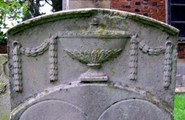 |
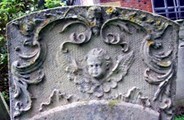 |
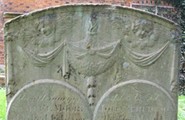 |
|
Angel flying -
rebirth, resurrection
Arch - victory in death
Arrow - mortality
Bird - eternal life
Cherub - angelic
Columns and doves - heavenly entrance
Corn - ripe old age
Crown - glory of life after death
Cup or chalice - the sacraments
Dove - purity, devotion
Drapes - mourning, mortality
Flower - fragility of life
Garland or wreath - victory in death
Handshakes - farewell
Harp - praise to the maker
Heart - love, love of God, mortality
Horns - the resurrection |
Ivy -
friendship and immortality
Lamb - innocence
Oak leaves and acorn - maturity, old age
Open book, bible - teacher, minister
Pick - death, mortality
Seashell - resurrection, life everlasting
Skeleton - life's brevity
Skull - mortality
Spade - morality, death
Sun rising - renewed life
Tree -life
Trumpeters - heralds of resurrection
Urn - immortality
Winged effigies - flight of the soul
Wreath on skull - victory over death
|
See also
The churchyard
The town
cemetery

Go to:
Main Index Villages
Index
|


